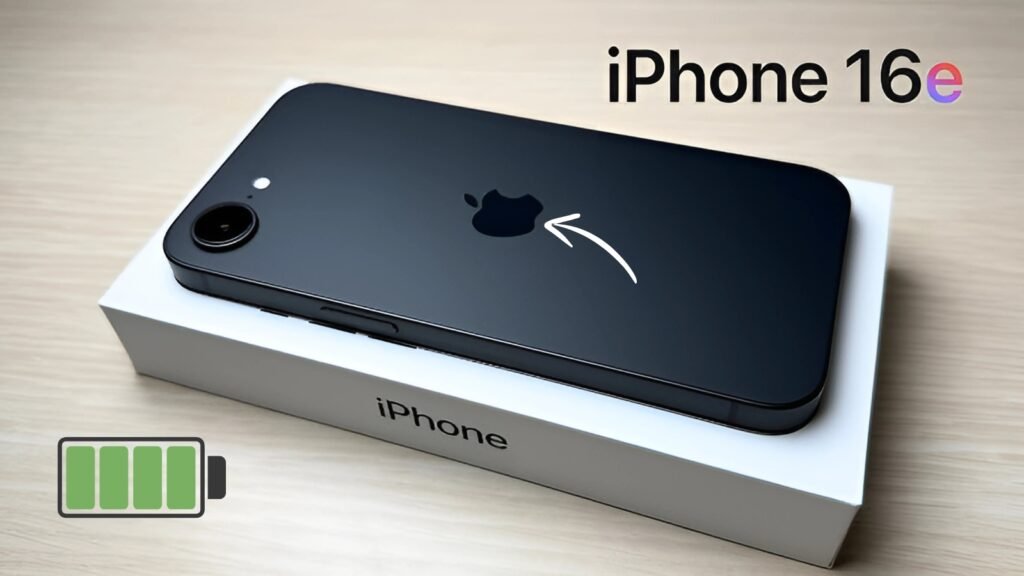iPhone 16e : Tim Cook’s trademark smile seemed extra bright during yesterday’s surprise announcement. Standing in Apple Park’s Steve Jobs Theater, he held up what looked like a standard iPhone before dropping the bombshell – this one runs for a full 24 hours of actual use. Not standby time, not with every feature disabled, but real-world, heavy usage.
The iPhone 16e represents Apple’s first major departure from their typical release cycle. Marketing executive Jennifer Chen explained over coffee after the event, “We kept hearing the same feedback. People love their iPhones but hate being tethered to chargers. So we asked ourselves – what if we solved just that one problem completely?”
Engineering for Endurance
The secret lies in multiple innovations working together. Apple developed a new silicon-carbon battery technology that increases capacity by 40% without adding bulk. The phone measures just 7.8mm thick, barely more than current models, yet packs a 4,800mAh battery – massive by iPhone standards.
But hardware tells only half the story. iOS 18.3, exclusive to the 16e initially, introduces “Adaptive Endurance Mode.” This isn’t your typical battery saver that cripples functionality. Instead, it uses on-device learning to predict usage patterns and pre-optimize power distribution. Check email frequently at 9 AM? The phone prepares for that without keeping mail constantly syncing all night.
The A18 Bionic chip, built on an advanced 3nm process, sips power while delivering flagship performance. Apple claims 50% better energy efficiency compared to the A16, achieved through architectural improvements and smarter core management. During demos, the phone handled intensive tasks without the usual battery percentage anxiety.
Design Philosophy Shifts
Aesthetically, the iPhone 16e looks familiar yet different. The chassis uses recycled titanium like its Pro siblings, but with a unique brushed finish that feels warmer to touch. Available in Midnight, Starlight, Product RED, and a new Sage Green, each color underwent extensive testing to ensure they age gracefully.
The camera bump exists but feels more integrated. Apple’s designers achieved this by gradually raising the back surface toward the cameras, creating a subtle wave effect. It’s the kind of detail you don’t notice immediately but appreciate over time. The phone rocks less on flat surfaces – a small but welcome improvement.
Weight comes in at 187 grams, heavier than the standard iPhone 16 but lighter than Pro models. The distribution feels centered, making one-handed use comfortable despite the 6.3-inch display. Apple includes a new “Comfort Grip” coating that provides subtle texture without attracting lint.

Display Innovation Saves Power
The “Super XDR” display represents another efficiency breakthrough. Using LTPO technology with variable refresh rates from 1Hz to 120Hz, it adjusts multiple times per second based on content. Reading static text? It drops to 1Hz. Scrolling Twitter? It ramps up smoothly. Gaming? Full 120Hz kicks in instantly.
Brightness efficiency improved too. The display reaches 2,200 nits peak brightness while using 30% less power than previous generations. Micro-lens technology focuses light more efficiently, reducing waste. Even at maximum brightness, battery drain remains manageable.
True Tone and Night Shift received updates that further reduce power consumption. The ambient light sensor now samples less frequently when conditions remain stable, saving precious milliamp-hours throughout the day.
Real-World Testing Surprises
Apple invited journalists to use the iPhone 16e for a full day without charging. The results? Impressive across the board. Heavy users streaming video, taking photos, navigating with GPS, and making calls ended their day with 15-20% remaining. Moderate users saw 35-40% left after 16 hours.
One tester documented their usage: two hours of Netflix, 90 minutes of gaming, constant messaging, an hour of video calls, music streaming during a workout, and heavy social media browsing. Battery remaining at 11 PM? 22%. That’s transformative for iPhone users accustomed to afternoon charging anxiety.
Charging speeds improved too. The included 30W adapter reaches 70% in 35 minutes. Wireless charging hits 15W with MagSafe, while reverse wireless charging finally arrives, letting you top up AirPods or even help a friend’s phone in emergencies.
Smart Features Extend Endurance
iOS 18.3’s battery features feel almost magical. “Predictive Charging” learns your routine and optimizes charging patterns. Leave for work at 8 AM daily? It’ll charge to 80% overnight, then top off just before you typically unplug. This reduces battery wear while ensuring full capacity when needed.
“App Efficiency Scores” show which apps drain battery excessively, with suggestions for alternatives or settings adjustments. Social media apps get called out for background refresh abuse, while the system offers one-tap fixes for common issues.
Background app refresh became smarter too. Instead of constant updates, apps sync in intelligent batches when the phone’s already active. Email, messages, and critical apps stay real-time, while less important apps wait for efficient moments to update.
Suzuki Access 125 became one of the best scooter for city girl’s
iPhone 16e Market Positioning and Impact
Priced at $799, the iPhone 16e sits between standard and Pro models. Apple positions it as the “worry-free iPhone” – for users who prioritize reliability over cutting-edge features. It’s a smart move, addressing the single biggest complaint about modern smartphones.
Pre-orders begin Friday, with availability expected within two weeks. Carrier partners report unprecedented interest, particularly from business users and travelers who need dependable all-day battery life. Android switchers citing battery concerns might finally find their reason to try iOS.
The iPhone 16e proves Apple can still surprise us. By focusing intensely on solving one problem completely, they’ve created something genuinely useful. In a world of incremental updates, that feels revolutionary.
